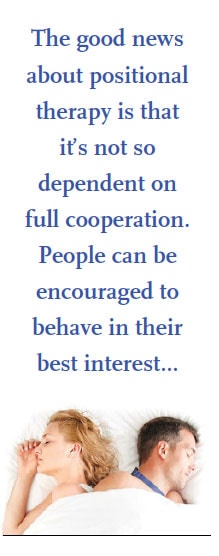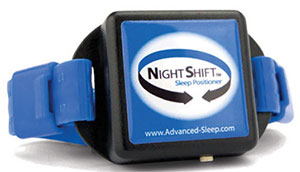Combining Technologies for Successful Outcomes with Innovations Like i-CAT, Ez Sleep, Night Shift and Apnea Guard®
 Targeted and disruptive technologies” is the space where Dental Sleep Medicine dentists have always lived. Whether we know it or not, we have been all about disruptive innovation in the medical device field, and more specifically within the field of sleep medicine. Positive Airway Pressure, introduced by Collin Sullivan in 1981, would become the treatment of choice for decades. But always close by were the dentists with their hunks of acrylic swimming in saliva, making up ground slowly, deliberately.
Targeted and disruptive technologies” is the space where Dental Sleep Medicine dentists have always lived. Whether we know it or not, we have been all about disruptive innovation in the medical device field, and more specifically within the field of sleep medicine. Positive Airway Pressure, introduced by Collin Sullivan in 1981, would become the treatment of choice for decades. But always close by were the dentists with their hunks of acrylic swimming in saliva, making up ground slowly, deliberately.

Introduced in 1995 by Harvard University professor Clayton Christensen, the theory of disruptive innovation has proven to be a powerful way of thinking about innovation-driven growth. The medical device industry, especially PAP-based technology, has enjoyed stability, strong growth, and good financial return over the last 35 years. However, disruptive change is already under way and the future of the industry will be different as patients seek and demand individualized approaches to their problems. Enter disruptive technologies, like Oral Appliance Therapy, positional therapy, Pharma approaches, gastric and nerve stimulation surgical modalities, as well as self-help technology like oropharyngeal exercise, to name only a few! But how does this disruptive technology get to patients and then lead to a personalized approach to care?
Technological Advancements that Help the Dentist
Change requires not only innovation but getting folks to think differently. That isn’t easy, especially when the existing technology works so well. CPAP works, and, it works great. Our patients are savvy and they are requesting treatment choices based on stories from their friends and family, and what they’ve researched on the Internet.
I was fortunate enough to begin my career in DSM among an elite and forward-thinking group of sleep docs at Scripps Clinic in La Jolla, California. My participation was interesting to them, and over time they began to see the benefits of my expertise. We came to agree to invest some time and resources into a formalized study that produced a sentinel clinical trial on the “Jaw Advancement Device. But even after showing very good outcomes, OAT remained little more than a curiosity for my docs, a rescue, a small possibility. But just as they said in the old Virginia Slims commercials: “You’ve come a long way way, Baby!” Back in the day, I could not have imagined the impact a digital workflow would have on my practice. Digital dentistry is here to stay and has spilled over into the DSM world with the advent of computer-guided appliance fabrication, such as the Narval and MicrO2 sleep appliances. Kudos to ResMed Inc. and MicroDental Laboratory for advancing this disruptive technology – a sure game-changer.
Another game-changer that I have come to count on for evaluation and thoroughness in my patient consultation and work-up is CBCT technology. I like that the i-CAT technology in particular has the least radiation exposure for my patients, and incredible imaging software abilities. In my observations of the images over the last two years, I have come to recognize traits that help me predict outcomes and what combination of therapies may be most helpful to that individual patient. The strongest impact is with patient education and helping the patient grasp an understanding of their condition and “own” the problem. They can then share ownership in the treatment as well.

One of the greatest weaknesses of OAT is difficulty predicting when patient success may be expected, and so far there is no reliable predictive model or phenotype. Then there’s the problem of our definitions: What is a successful outcome? An AHI that drops below 5? Below 10? Whichever of these is your treatment goal, (and we’ll save that argument for later) treatment with oral appliances all too often falls short of expectations. The dedicated clinicians must ask themselves: What else can I do to help
my patient?
Maximizing Outcome Through Titration Strategies
Although titration strategies are becoming more refined, finding the right starting position of the mandible at the beginning remains critical. Relief from apnea can actually be facilitated very early in the therapy. In one novel and scientifically validated technique, the dentist may use a trial oral appliance called the Apnea Guard to correctly determine the starting position for a custom appliance. The Apnea Guard protocol takes both vertical and protrusive variables into account to correctly predict the most efficacious position of the jaw through a proprietary algorithm. Since the Apnea Guard has proven outcome equivalency compared to a custom appliances, the device provides the dentist and the sleep physician an added opportunity to accurately identify responders to OAT before a custom appliance is offered to a patient. This system has the added benefit of providing the patient with immediate treatment of their sleep disordered breathing while the patient waits for the weeks necessary for the custom MAD.
 Having the ability to correctly predict which patient will respond to therapy is an astounding breakthrough for skeptical physicians and unsure patients. Never before have we had a scientifically proven, inexpensive, trial device to identify the ideal jaw position for effectiveness that also provides immediate treatment for our drowsy patients. CPAP therapy has always been quick to initiate; Apnea Guard allows OAT to progress from testing to therapy almost immediately as patients leave the sleep center.
Having the ability to correctly predict which patient will respond to therapy is an astounding breakthrough for skeptical physicians and unsure patients. Never before have we had a scientifically proven, inexpensive, trial device to identify the ideal jaw position for effectiveness that also provides immediate treatment for our drowsy patients. CPAP therapy has always been quick to initiate; Apnea Guard allows OAT to progress from testing to therapy almost immediately as patients leave the sleep center.
 Deploy Additional Therapies When Expectations Aren’t Met
Deploy Additional Therapies When Expectations Aren’t Met
So what is the trained, caring dentist to do next? What therapies can be added to our Oral Appliance in order to improve results? Well, we have more options than you may think. And it all started with a tennis ball…
Positional Therapy
Positional therapy was first formally studied by Cartwright and others, who used biofeedback to keep folks off their backs when they slept. Feedback came from a tennis ball sewn into the back of the nightshirt. They demonstrated successfully that positional-dependent patients improved their AHI with the tennis ball shirt by eliminating supine sleep. Fantastic! So, would it help the dentist to add positional therapy when their patient has residual apnea while supine and wearing their appliance? One would think so.
The good news about positional therapy is that it’s not so dependent on full cooperation. People can be encouraged to behave in their best interest, by sleeping on their sides, with a simple ‘reminder’ device worn on the body that gently prods the patient out of supine sleep. The Night Shift is a comfortable, electronic trainer that vibrates quietly to prompt a turn, kind of like a bed partner, but without the elbows! The Night Shift has been carefully validated and FDA cleared for use by every member of the sleep health team, including dentists. The vibration produced is similar to your cell phone, does not diminish sleep efficiency, and reduces supine sleep to lower AHI.
Tongue Push-ups?
It is reasonably well understood now that there are two primarily important mediators of airway collapse in sleep: Anatomical deficiency and/or an inadequate neuromuscular response. Oral appliances, like CPAP or surgery address anatomical narrowing by enlarging the retro-glossal or velopharyngeal spaces. The chief difference that most likely accounts for the superior effects of PAP over other treatments is that pneumatic inflation eliminates any need for airway dilation muscles to function. Other treatments that improve airway caliber still rely on the patient’s muscle tone to defend against the challenge of airway collapse, a function that is commonly lost in OSA patients. Can that response be rehabilitated? The answer is most likely yes.

Enter the myofunctional therapist. If you haven’t explored this field and made friends with a local therapist yet, you should consider it. The myofunctional therapist can play an important role in helping the DSM dentist reach success through rehabilitation of muscle strength, and a restoration of proper resting tongue posture. There is good evidence to support its use either as a stand-alone therapy in the correctly selected patient, or as an adjunct to OAT.
Conclusion
In summary, the DSM dentist has more tools than ever to help them succeed, by whatever definition you choose. First of all, seek out a reliable clinical approach driven by evidence clinical approach and made practical by convenience. Secondly, be prepared to supply adjunctive therapies that push your results into that winning zone. And third, partner with a disruptive Home Sleep Testing Company like Ez Sleep to combine technologies that can enable you to reach successful outcomes. Build your reputation around versatility and achieving great results every time. Stay disruptive!



